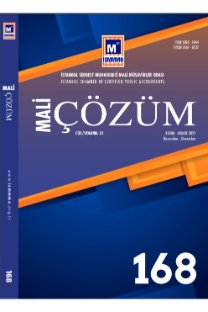HALKA AÇIK FİNANS DIŞI ŞİRKETLERDE SÜREKLİLİK RİSKİNİN KARAR AĞACI MODELİ İLE ÖNGÖRÜLMESİ
Bu çalışmanın amacı bir makine öğrenmesi modeli olan karar ağacının fians dışı şirketlerin süreklilik risklerinin öngörülmesine yapabileceği katkının irdelenmesidir. Çalışma kapsamında yapılan analizlere 1999-2016 döneminde Türkiye’de yerleşik, halka açık, fians sektörü dışındaki şirketler dâhil edilmektedir. Araştırmada R istatistik dilinden ve ilgili R makine öğrenmesi model kütüphanelerinden (rpart ve partykit) faydalanılmaktadır. Modelin etkinlik ölçümleri çapraz doğrulama yöntemi ile gerçekleştirilmektedir. Çalışma sonucunda veriye uygulanan karar ağacı modelinin %91 seviyesinde bir başarı ile süreklilik risklerini öngörebildiği tespit edilmektedir. Model, eldeki örneklem çerçevesinde, yüksek performansının yanında kolay anlaşılır ve uygulanabilir olmasıyla pratikte de faydalı olabileceğine işaret etmektedir. Ortaya çıkan Karar Ağacı modelinin her seviyedeki muhasebe bilgi kullanıcısı (yöneticiler, ortaklar, kredi kuruluşları, çalışanlar, potansiyel ortaklar, devlet ve toplum) tarafından işletilebilmesi ve kredi riski takip uygulamalarına eklemlenebilmesi mümkün görünmektedir
GOING CONCERN PREDICTION VIA DECISION TREE MODELS AMONG NON-FINANCE PUBLIC COMPANIES
This research aims to determine the potential of decision trees, a subclass of machine learning models, in going concern prediction among non-fiance public companies. Data used in the study to construct the model includes nonfiance Turkish companies traded publicly in 1999-2016 period. R statistical language and related machine learning libraries (rpart and partykit) are utilized to train the model. Performance of the model is estimated via cross-validation, a commonly accepted method. The study shows that, the decision tree model applied to the data attains a prediction performance of 91%. Besides being very effective machine learning models for the current scenario, decision trees also appear to be very easy to comprehend and build. It is foreseen that, decision tree models can be utilized by credit analysts at any level and be incorporated to any credit analysis software without much effort.
___
- Aziz M. A. ve Dar H. A. (2006). Predicting Corporate Bankruptcy: Where do We Stand? Corporate Governance: The International Journal of Business in Society, 6 (1): 18-33.
- Belowary J., Giacomina D. and Akers M. (2007). A Review of Bankruptcy Prediction Studies: 1930-Present. Journal of Financial Education, 33 (Güz sayısı): 1-42.
- Bolak M. (2004). Risk ve Yönetimi. İstanbul: Birsen Yayınevi.
- Breiman L., Friedman J. H., Olshen R. A. and Stone C. J. (1984). Classifiation and Regression Trees. Monterey: Wadsworth & Brooks / Cole Advanced Books & Software.
- Dimitras A., Zanakis S. and Zopounidis C. (1996). A Survey of Business Failures with an Emphasis on Prediction Methods and Industrial Applications. European Journal of Operational Research, 90: 487-513.
- Gaeremynck A. and Willekens M. (2003). The Endogenous Relationship Between Audit Report Type and Business Termination: Evidence on Private Firms in a Non-litigious Environment. Accounting and Business Research, 33 (1): 65- 79.
- Goldberger A. S., (1991). A Course in Econometrics. Cambridge: Harvard University Press.
- Gruszczynski M. (2015). Issues in Modelling the Financial Distress and Bankruptcy of Companies. Quantitative Methods in Economics, 16 (1): 96-107.
- Güredin E. (2014). Denetim ve Güvence Hizmetleri 14. bs.. İstanbul: Türkmen Kitabevi.
- Hopwood W., McKeown J. and Mutchler J. (1989). A Test of the Incremental Explanatory Power of Opinions Qualifid for Consistency and Uncertainty. The Accounting Review, 64 (1): 28-48.
- Hopwood W., McKeown J. and Mutchler J. (1994). A Reexamination of Auditor Versus Model Accuracy within the Context of the Going-concern Opinion Decision. Contemporary Accounting Research, 10 (2): 409-431.
- Jones F. (1987). Current Techniques in Bankruptcy Prediction. Journal of Accounting Literature, 6: 131-164.
- Lennox C. (1999). The Accuracy and Incremental Information Content of Audit Reports in Predicting Bankruptcy. Journal of Business Finance & Accounting, 26 (5-6): 757-778.
- McKee T. (1995). Predicting Bankruptcy via Induction. Journal of Information Technology, 10 (1): 26-36.
- Neophytou E., Charitou A. and Charalambous C. (2001). Predicting Corporate Failure: Emprical Evidence for the UK. University of Southampton, School of Management, Discussion Paper, 1 (173): 1-30.
- Platt H. D. and Platt M. B. (1990). Development of a Class of Stable Predictive Variables: The Case of Bankruptcy Prediction. Journal of Banking, Finance and Accounting, 17 (1): 31-51.
- Samuel A. L. (1959). Some Studies in Machine Learning Using the Game of Checkers. IBM Journal of Research and Development, 3 (3): 210-229.
- Sayın G. (2019). Halka Açık Finans Dışı Şirketlerde Süreklilik Riskinin Makine Öğrenmesi İle Öngörülmesi. Yayımlanmamış Doktora Tezi, İstanbul Aydın Üniversitesi.
- Therneau T.M. (1983). A Short Introduction to Recursive Partitioning. Stanford University, Department of Statistics, Orion Technical Report, 21: 1-11.
- ISSN: 1303-5444
- Yayın Aralığı: Yılda 6 Sayı
- Başlangıç: 1991
- Yayıncı: İstanbul Serbest Muhasebeci Mali Müşavirler Odası
Sayıdaki Diğer Makaleler
YÖNETİM KARARLARI AÇISINDAN KARBON MUHASEBESİ BİLGİLERİNİN ÖNEMİ
Mustafa KARTAL, Neşe ÇOBAN ÇELİKDEMİR
HALKA AÇIK FİNANS DIŞI ŞİRKETLERDE SÜREKLİLİK RİSKİNİN KARAR AĞACI MODELİ İLE ÖNGÖRÜLMESİ
MUHASEBE VE KAPİTALİZM; TANZİMAT DÖNEMİ İKTİSADİ ZİHNİYETİ VE ŞİRKET-İ HAYRİYE MUHASEBE DÜZENİ
Pınar DALOĞLU, Miraç Sema ÜLKER
BÖLGESEL GİRİŞİMCİLİK FAALİYETLERİNİN MALİ TEŞVİK UYGULAMALARI AÇISINDAN DEĞERLENDİRİLMESİ
BESİCİLİK FAALİYETİNDE KAZANÇ TÜRÜNÜN BELİRLENMESİ
BİLGİSAYAR DESTEKLİ DENETİM ARAÇ VE TEKNİKLERİNİN UYGULANMASI
YÜKSEKÖĞRETİM KURUMLARINDA FAALİYET TABANLI MALİYETLEME VE VAKIF MESLEK YÜKSEKOKULUNDA BİR UYGULAMA
